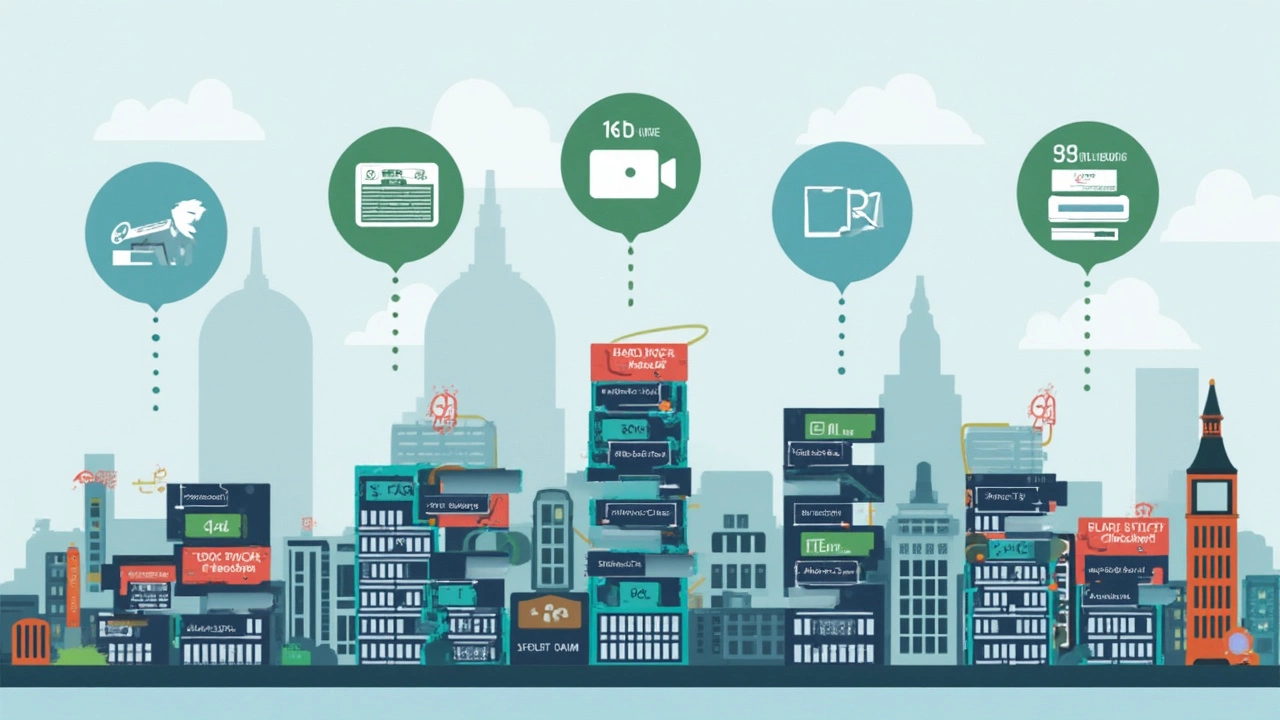Least Expensive Storage Device: What’s the Best Budget Option?
 Apr, 26 2025
Apr, 26 2025
So you’re after a cheap way to store your files. Walk into any electronics store or scroll through an online shop, and you’ll get bombarded with techy terms—SSD, HDD, flash, SD cards, even old-school DVDs. If you’ve ever wondered which device lets you save the most stuff for the least cash, you’re not alone.
The main thing most people care about is price per gigabyte—that is, how much space you’re getting for your dollar. Different devices advertise different speeds and features, but when your budget is tight, all that matters is stretching each dollar as far as it can go.
Some people still use DVDs or CDs for archiving. Surprising, right? They’re dirt cheap, but come with annoyances and aren’t practical for files you use daily. Jump drives (USB sticks), on the other hand, get tossed into backpacks everywhere—they’re small, handy, and affordable for a few gigabytes, but once you need bigger capacity, things change.
Let’s get past the marketing noise. Want the best value for photos, movies, or even that work project you keep forgetting to back up? Knowing the pros and cons, plus a few insider tricks, can save you cash and headaches.
- The Big Picture: Types of Storage Devices
- Price Per Gigabyte: Breaking Down the Costs
- Cheapest Picks for Different Needs
- Hidden Costs and Reliability
- Tips for Saving Money on Storage
The Big Picture: Types of Storage Devices
When you’re sizing up storage options, it helps to know what’s out there and what each device is actually good for. The usual suspects are hard drives, flash drives (USB sticks), SD cards, solid-state drives (SSDs), and even good old DVDs. Each type is built differently, and costs can be all over the place.
Here’s how they stack up:
- Hard Disk Drives (HDDs): Old-school but reliable. These come in desktop or portable versions, and you’ll find them in capacities as low as 500GB to several terabytes (TB, that’s 1,000 gigabytes). Best for tons of storage at a low price.
- USB Flash Drives: Super portable and easy to use. You just pop them into your laptop or desktop. They’re cheap for small amounts of data, but high-capacity versions get pricey fast.
- SD and microSD Cards: You see these everywhere in cameras, phones, and even game consoles. They’re tiny but can pack a punch—sizes now go up to 1TB, but most people settle around 32GB-128GB for daily use.
- Solid-State Drives (SSDs): These are the speedy ones. No moving parts means they transfer files super fast and aren’t as likely to break if you drop them. The price per gigabyte has dropped a lot, but they’re still more expensive than regular hard drives for the same space.
- Optical Discs (DVDs, Blu-ray): Not popular for everyday storage anymore, but if you’re stashing away backup copies and don’t need quick access, a stack of DVDs is dirt cheap per gigabyte.
For a quick side-by-side, look at this breakdown:
| Device Type | Typical Capacity | Typical Price (USD, 2025) |
|---|---|---|
| HDD (External, 2TB) | 2TB | $45-$60 |
| USB Flash Drive (64GB) | 64GB | $7-$10 |
| SD Card (128GB) | 128GB | $12-$20 |
| SSD (External, 1TB) | 1TB | $55-$80 |
| DVD-R (Single Disc) | 4.7GB | $0.25 |
Long story short, HDDs and optical discs tend to give the most space for your money, but other devices win for convenience or speed. Which one is best for you depends on how much stuff you’re storing and how you’ll use it.
Price Per Gigabyte: Breaking Down the Costs
Let’s talk numbers. If you want the cheapest storage, you have to look past the price tag and zoom in on price per gigabyte. It’s a simple calculation—just divide the cost of the device by the storage size. This tells you exactly how much each gigabyte is costing you, and it’s a great way to compare a flash drive with a massive external hard drive or even a stack of DVDs.
To show how this really plays out, here’s a quick look at real prices as of early 2025:
| Device Type | Average Price | Capacity | Price per GB |
|---|---|---|---|
| USB Flash Drive | $8 | 64GB | $0.13 |
| External Hard Drive (HDD) | $50 | 2TB | $0.025 |
| SD Card | $10 | 128GB | $0.08 |
| DVD-R | $0.30 | 4.7GB | $0.06 |
| SSD | $90 | 1TB | $0.09 |
That chart shows something interesting—the big external hard drives give you the most storage for your money, often less than three cents per gigabyte. SD cards and DVDs land in the middle. Flash drives are pricier for each gigabyte, even though the initial price is lower. And SSDs? Super fast, but you’re paying extra for speed.
If all you care about is getting a ton of storage for cheap, large hard drives are the winner. But if you want to slip files in your pocket or need something for a phone or camera, you might pay a little more per gigabyte for SD cards or a USB flash drive. It’s all about matching the device to your real-life needs—and your budget.

Cheapest Picks for Different Needs
Finding the least expensive storage device really depends on what you’re trying to store—and how often you need to access it. There’s no one-size-fits-all, but you can definitely stretch your dollar if you match the type of storage with what you need.
If you just want to stash away documents, photos, or music and don’t need blazing speed, external hard drives (HDDs) are usually the top pick for saving money. As of 2025, you can easily find a reliable 1TB external HDD for around $40, which knocks the price down to about 4 cents per gigabyte. That’s tough to beat if you need lots of space. These are great for backing up an entire laptop or storing years of photos and movies. They're not fast, but for backing up or archiving, they’re champions.
Flash drives and SD cards are king when it comes to portability. For smaller needs—like moving school reports or a handful of photos—they’re hard to beat. A 64GB USB stick will often run you less than $10. That’s about 16 cents per gigabyte—more expensive than an HDD, but way more convenient if you just need to plug-and-play at school or work. SD cards are handy for cameras, handheld consoles, and phones, with similar pricing.
On the other hand, DVDs and CDs still pop up as the dirt-cheap answer for archiving. You can get a 50-spindle of blank DVDs for about $15, which stores 4.7GB per disc. That drops the price to about 6 cents per gigabyte. But, here’s the catch—nobody wants to burn 100 DVDs just to save their vacation photos, and most new laptops don’t even have disc drives anymore.
Here’s a quick look at how the most common storage devices compare on price per gigabyte (as seen in early 2025):
| Storage Type | Average Cost per Unit | Capacity (GB) | Price per GB |
|---|---|---|---|
| External HDD | $40 | 1000 | $0.04 |
| USB Flash Drive | $10 | 64 | $0.16 |
| SD Card | $12 | 64 | $0.19 |
| DVD | $15 (50-pack) | 235 | $0.06 |
| External SSD | $60 | 500 | $0.12 |
For folks needing a little storage here and there for day-to-day tasks, flash drives and SD cards are totally fine. If you want massive space and don’t need to carry it in your pocket, an external HDD is the clear budget winner. And if you’re all about archiving and okay with old hardware, DVDs still have a spot. For anyone who values speed as much as cost, external SSDs are finally dropping in price, but they’re rarely the cheapest.
Always double-check the reviews on any super-cheap storage device—that bargain USB stick might end up being a headache if it fails. Sticking with well-known brands often saves hassle in the long run, even if you pay a dollar or two more.
Hidden Costs and Reliability
Finding the cheapest storage device isn’t just about shelf price. There are sneaky extra costs and headaches that don’t show up until you’re actually using your gear. That “amazing deal” can end up costing more in lost files, hours of frustration, or straight-up replacement money.
Let’s talk about reliability first. Classic hard drives (HDDs) look like a steal, especially for huge amounts of storage. But they’ve got spinning parts inside, and guess what—those moving parts are where things go wrong. Dropping an external HDD, even from your desk to the carpet, can mean the end of your files. Those files matter way more than a couple bucks you save up front.
Flash drives and SD cards (sometimes called thumb drives or memory cards for phones/cameras) use solid-state tech. No moving parts. They handle drops better, but here’s the kicker: they wear out over time, especially with lots of rewrites. Manufacturers rarely tell you how many rewrite cycles you get, so you won’t know until one randomly bites the dust.
Now, hidden costs. Most cheap storage comes with short or limited warranties—if there’s any at all. When that USB stick goes bad after six months, good luck getting a free swap.
- Flash drives: Lose them easily (they’re tiny), and you’ll need to buy another. Definitely budget for a backup, since cost per gig goes up if you keep replacing them.
- External hard drives: Need a protective case if you’re moving it around, which adds to the total spend. And when an HDD fails, recovering data through a professional can cost hundreds, if not more.
- SD cards: Not all devices support the largest (and sometimes cheapest, per gig) SD cards, so double-check compatibility or you’ll waste money on unusable purchases.
- Optical discs (like DVDs): Need a drive to read them. New laptops rarely have disc readers anymore, and external DVD drives aren’t free.
Check this out—real numbers on average failure rates and extra costs:
| Device Type | Average Failure Rate (3 years) | Typical Extra Costs |
|---|---|---|
| HDD | About 4-6% | Protective case, possible data recovery fees |
| Flash Drive | 2-5% | Replacement (they get lost), no recovery if it dies |
| SD Card | 1-3% | Reader/adapter for some devices |
| DVD | Less than 1% | External drive if you don’t have one |
Bottom line? When you compare storage devices, cheap up front doesn’t always mean cheap in the long run. Go for something that fits your needs, but add up all the ‘extras’ before you buy. Planning for a backup solution, even if it’s a cheap second flash drive, can save you a ton of disappointment—and yes, money.

Tips for Saving Money on Storage
Here’s where you can really stretch your budget. You don’t need a fancy storage device if all you want is space to dump files or photos. Here are some ways to make sure you get the most space for your money:
- Buy in Bulk or Larger Sizes: Smaller flash drives might look cheap, but when you check the price per gig, bigger models usually cost way less per GB. A 1TB hard drive almost always beats a stack of 32GB flash drives for value.
- Look for Sales—Especially Online: Big shopping days like Black Friday or Amazon Prime Day regularly discount storage device prices. Even outside these events, you’ll notice SSDs and hard drives getting cheaper every year.
- Consider Refurbished Drives: Companies sell factory-refurbished hard drives and SSDs with warranties. You pay less but still get some protection. Just avoid sketchy sellers—stick with reputable shops.
- Avoid Gimmicks: “Ultra-fast” or “rugged” drives sound cool, but if you just want basic storage, skip the fancy features. You can get lots more gigabytes for your money if you keep things simple.
- Check Reliability Ratings: It’s tempting to buy the absolute cheapest device, but nothing kills a bargain like a lost file. Brands like Western Digital, Seagate, and SanDisk have solid reliability records. User reviews on sites like Amazon or Reddit tell you which cheap drives actually last.
If you’re storing bigger files (like videos), skip the flash drive and spring for an external HDD or SSD. For basic documents, a SD card or small USB stick is fine. Avoid microSD cards for important data—they’re great for cameras, but easy to lose and not always super reliable.
| Device Type | Price Per GB (USD) |
|---|---|
| External Hard Drive (1TB+) | $0.03 – $0.04 |
| SATA SSD (1TB+) | $0.06 – $0.08 |
| Flash Drive | $0.10 – $0.15 |
| SD Card | $0.12 – $0.18 |
| DVDs (Bulk) | $0.02 – $0.03 |
Want to save long term? Every few months, check for price drops and read up on new tech. Prices change—today’s bargain could be half price in a year. Quick pro tip: Always back up anything important on at least two different devices. No point in saving cash if you lose your data!